Planning performance statistics: second quarter, 2017-2018
The latest statistics on planning application decision-making and timescales from July to September 2017-2018.
2. Local Developments
Local developments include applications for changes to individual houses and smaller developments for new housing as well as applications covering areas of development such as minerals, business & industry, waste management, electricity generation, freshwater fish farming, marine finfish farming, marine shellfish farming, telecommunications, Approval of Matters Specified in Conditions ( AMSCs) and other developments.
This section presents quarterly information on average timescales across all local developments, along with separate figures for the key categories of householder, housing, business and industry and other developments. Information on other categories of development is reported on an annual rather than quarterly basis.
Figures for all applications, which include legacy cases validated before 3 rd August 2009, are shown up to the end of 2016/17. From quarter one 2017/18, because of the limited number of legacy case still being processed, figures are only shown for applications validated post August 2009.
2.1. All Local Developments
There were 6,849 applications (excluding legacy cases) for local developments decided in quarter two of 2017/18, 118 (1.7 per cent) fewer than the 6,967 decisions in the previous quarter, but 165 (2.5 per cent) more applications than the 6,684 decisions in quarter two of 2016/17. The average decision time for these 6,849 local developments was 9.0 weeks, slower by just over a day compared to the previous quarter (8.8 weeks), but slightly quicker than the corresponding 2016/17 quarter two figure of 9.1 weeks.
In the second quarter of 2017/18 the percentage of decisions made in less than two months was 74.3 per cent, down from both the previous quarter (77.6 per cent) and from the corresponding quarter two figure of 76.3 per cent in 2016/17.
Chart 5: All Local Developments: Number of decisions
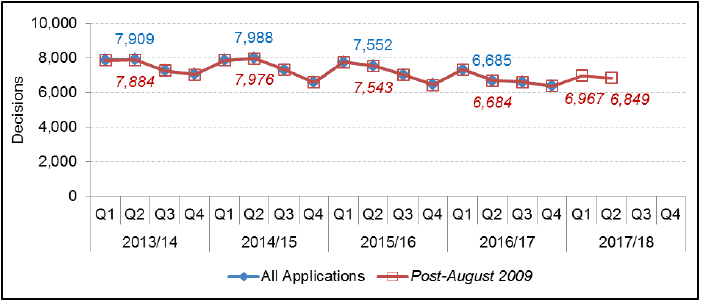
Chart 6: All Local Developments: Average decision time (weeks)
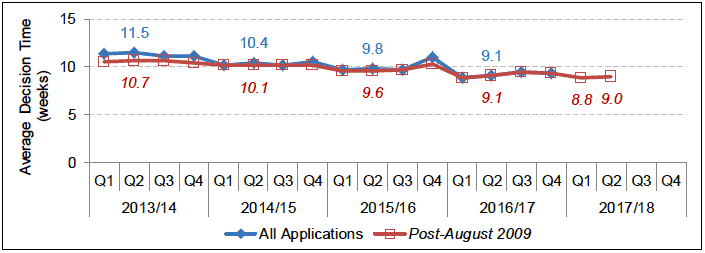
The 2015/16 Q4 All Applications figure was revised in January 2018 from 11.1 to 11.0
Chart 7: All Local Developments: Percentage of decisions within two months
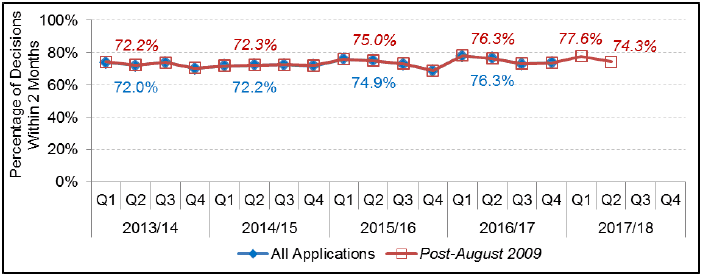
In quarter two of 2017/18 there was one local development that was a pre 3rd August 2009 legacy case. Further details about legacy cases can be seen in Section 10.
In addition, there were 423 local development applications concluded in quarter two of 2017/18 that were subject to separate processing agreements and are not included in average time calculations. 344 (81.3 per cent) of these applications met the agreed timescales that had been set between developers and local authorities. For the most recent quarter, local applications with processing agreements accounted for just under six per cent of the decisions made for all local developments.
In quarter two of 2017/18 Highland made the most decisions on local developments (672 in total), 670 of these had an average decision time of 10.8 weeks and a further two local applications had processing agreements with both meeting the agreed timescales that had been set between the developer and local authority, ( Quarter 2, 2017/18 – Tables 1 & 3).
2.2. Local (Non Householder) Developments
This can include applications for smaller developments for new housing as well as applications covering areas of development such as minerals, business & industry, waste management, electricity generation, freshwater fish farming, marine finfish farming, marine shellfish farming, telecommunications, Approval of Matters Specified in Conditions ( AMSCs) and other developments.
There were 3,372 local (non householder) developments decided during the second quarter of 2017/18, with an overall average decision time of 10.8 weeks. This is slightly slower than the previous quarter (10.7 weeks) which was the quickest for any quarter since the start of the data collection in 2012/13.
The percentage of local (non householder) developments decided within two months is 60.6 per cent, down from the previous quarter (64.8 per cent) and from the quarter two figure in 2016/17 (65.3 per cent) ( Quarter 2, 2017/18 – Table 5).
Chart 8: Local Developments (Non Householder): Number of decisions
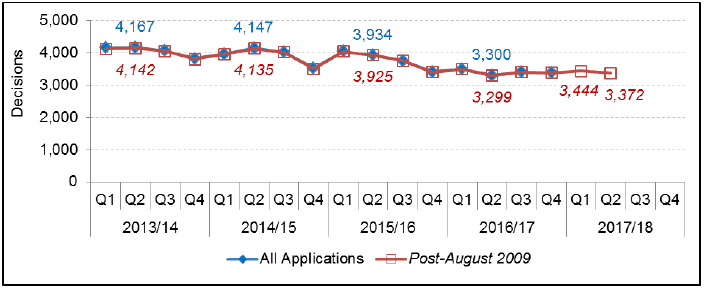
Chart 9: Local Developments (Non Householder): Average decision time (weeks)

Chart 10: Local Developments (Non Householder): Percentage of decisions within two months
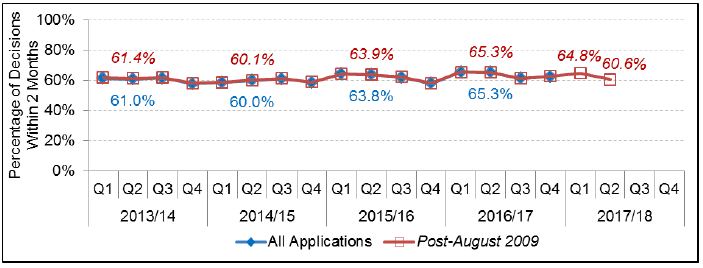
There were a further 309 Local Developments (Non Householder) applications concluded that were subject to separate processing agreements, 251 (81 per cent) met the agreed timescales.
2.3. Householder Developments
These include all applications for development in the curtilage of a residential property which are not change of use, for example: exensions, alterations to garages, swimming pools, walls, fences, driveways or porches.
There were 3,477 householder applications decided during the second quarter of 2017/18, with an overall average decision time of 7.2 weeks, an increase from the previous quarter (7.0 weeks) but a slight decrease from the equivalent quarter two figure in 2016/17 (7.3 weeks).
Chart 11: Householder Developments: Number of decisions
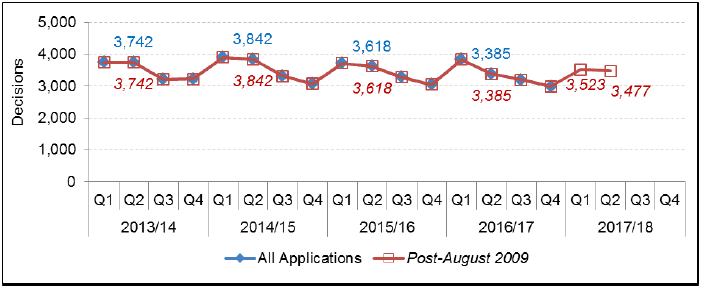
Chart 12: Householder Developments: Average decision time (weeks)
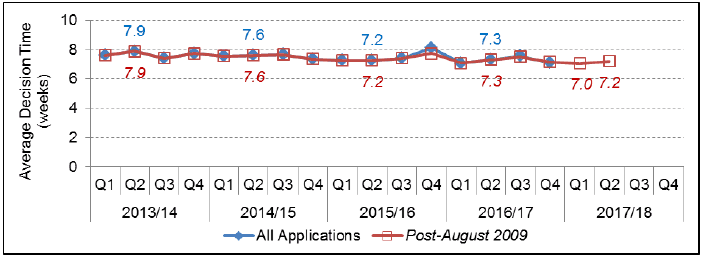
The percentage of householder applications decided within two months was 87.5 per cent in quarter two of 2017/18, down from the previous quarter (90.2 per cent) which was the highest figure for any quarter since the start of the data collection in 2012/13 but the highest Quarter 2 figure since the start of the data collection ( Quarter 2, 2017/18 – Table 6).
Chart 13: Householder Developments: Percentage of decisions within two months

There were a further 114 householder development applications concluded that were subject to separate processing agreements, 93 (82 per cent) of which met their agreed timescale. In the previous quarter 82 per cent (82 of 100 householder applications) also met the agreed timescales.
2.4. Local Housing Developments
Local Housing developments are those that have less than 50 dwellings and a site area that is less than 2 hectares.
In quarter two of 2017/18 there were 1,229 decisions made on local housing applications. The overall average decision time was 12.8 weeks, slower by four days compared to the previous quarter (12.2 weeks) which was the quickest since data collection started in 2012/13.
Chart 14: Local Housing Developments: Number of decisions

Chart 15: Local Housing Developments: Average decision time (weeks)
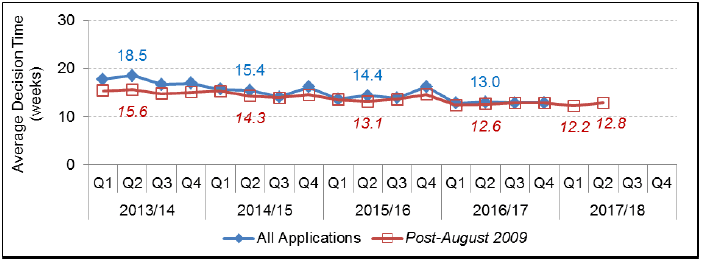
The percentage of local housing applications decided within two months was 51.0 per cent, lower than both the previous quarter (55.7 per cent) and the quarter two figure in the previous year (60.6 per cent) ( Quarter 2, 2017/18 – Table 8).
Chart 16: Local Housing Developments: Percentage of decisions within two months
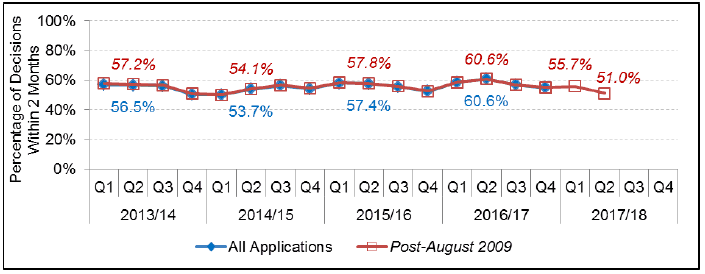
There was one local housing legacy case decided in quarter two of 2017/18. Further details about legacy cases can be seen in Section 10.
There were a further 157 local housing applications concluded that were subject to separate processing agreements, of which 79 per cent (124 applications) met the agreed timescale. This compares with 82 per cent (128 of 156 local housing applications) that met the agreed timescale for the previous quarter.
2.5. Local Business and Industry Developments
Business and Industry developments include construction of a building or structure for any of the following: use as an office, for research and development of products or processes, for any industrial process or for use for storage or as a distribution centre.
To be classed as local the gross floor space as a result of the development must not exceed 10,000 square metres and the site area must be 2 hectares or less.
There were 390 local business and industry applications decided during the second quarter of 2017/18, with an average decision time of 8.9 weeks, quicker by four days compared to the previous quarter (9.5 weeks) and the quickest quarter 2 figure since data collection started in 2012/13.
The percentage of local business and industry applications decided within two months was 70.3 per cent, up slightly from the previous quarter (69.9 per cent) but down from the equivalent quarter two figure in the previous year (71.1 per cent) ( Quarter 2, 2017/18 – Table 10).
Chart 17: Local Business and Industry Developments: Number of decisions

Chart 18: Local Business and Industry Developments: Average decision time (weeks)

Chart 19: Local Business and Industry Developments: Percentage of decisions within two months
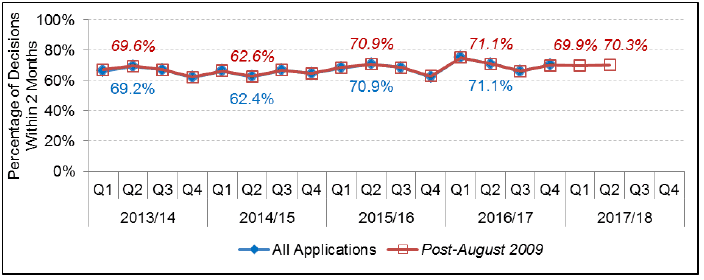
There were a further 32 local business and industry applications concluded that were subject to separate processing agreements, of which 94 per cent (30 applications) met the agreed timescale. This compares with 77 per cent (20 of 26 local business and industry applications) that met the agreed timescale for the previous quarter.
2.6. Local Other Developments
Other developments are developments not falling wholly within any other single class. They include but are not limited to retail, leisure and entertainment, education, healthcare, community facilities, transport interchanges, water and drainage developments and projects. This class also covers mixed use projects.
Local Other developments are those where the gross floor space of any building, structure or erection as a result of such development is less than 5,000 square metres and the area of the site is less than 2 hectares.
There were 1,515 local other developments decided during the second quarter of 2017/18, with an average decision time of 9.7 weeks, slightly slower than the 9.6 weeks for both the previous quarter and quarter two in 2016/17.
In quarter two of 2017/18 the percentage of local other developments decided within two months was 66.5 per cent, down from the previous quarter (70.2 per cent), and from the equivalent quarter two percentage in 2016/17 (68.2 per cent) ( Quarter 2, 2017/18 – Table 12).
Chart 20: Local Other Developments: Number of decisions
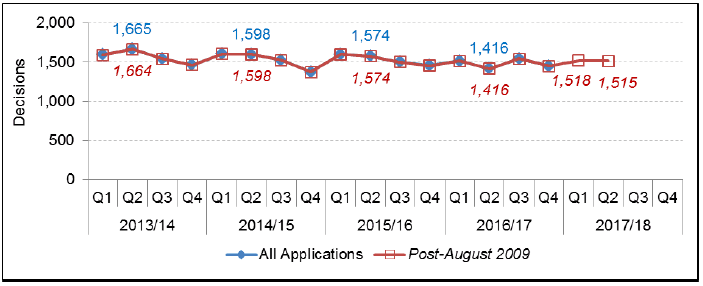
Chart 21: Local Other Developments: Average decision time (weeks)
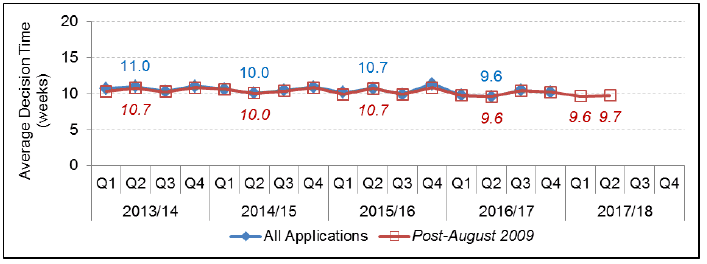
Chart 22: Local Other Developments: Percentage of decisions within two months
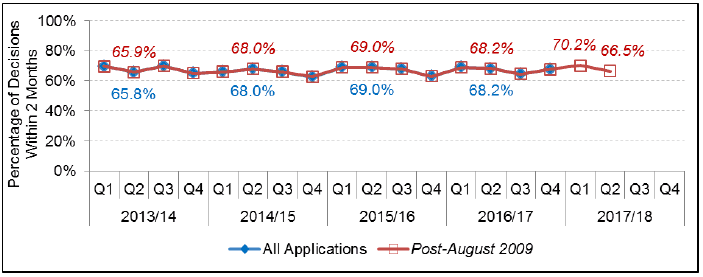
There were a further 99 local other developments applications concluded that were subject to separate processing agreements, of which 81 per cent (80 applications) met the agreed timescale. This compares with 79 per cent (58 of 73 local other developments) that met the agreed timescale for the previous quarter.
Contact
There is a problem
Thanks for your feedback